Home » Your Local Area » Eurobodalla
Local Profile for Eurobodalla Shire Council
Eurobodalla Local Government Area
Hazard Exposure Summary
Climate Change Data Summary
Risk Exposure Summary
Reference
Located on the south-east New South Wales (NSW) coast, Eurobodalla Shire Council covers a vast area comprising predominantly of areas of environmental significance and relatively small populated towns. The Shire is approximately 80 kilometres south of Sydney and 150 kilometres south-east of Canberra. The Shire extends from South Durras in the north to Akolele in the south and Nerrigundah in the west.
Council acknowledges the Yuin Nation as the traditional custodians of the lands and waters of Eurobodalla Shire. The Yuin cultural area is generally stated to extend from the Shoalhaven River in the north, to the Victorian border in the south and to the eastern edge of the tablelands in the west¹. Eurobodalla’s original inhabitants are the Durgha-speaking people of the Yuin nation Eurobodalla is named from an Aboriginal word meaning “small haven for boats” or “land between waters”.
The Shire covers a vast area, consisting of approximately 110km of coastline, 83 beaches, four major river systems, 10 national parks and 15 state forests.
There are three main townships in the Shire, Moruya is the administrative centre, Batemans Bay and Narooma. These are supported by several coastal and inland villages including South Durras, Nelligen, Mogo, Tuross Head, Bodalla, Dalmeny, Montague Island, Mystery Bay and the Tilba.
Socio-Demographic Profile
In 2024, the estimated residential population for Eurobodalla Shire was 41,142 people. ²
In 2021, based on the Australian Bureau of Statistics (ABS) 2021 census data, Eurobodalla Shire consisted of:
- LGA size – 3,422 square kilometres; ³
- Total population – 40,453 people; ⁴
- Aboriginal and Torres Strait Islander population – 6.1% (2,467 persons); ⁵
- No of properties/dwellings – 24,593; ⁶
- Persons aged under 5 – 4.1% (1,648 persons); ⁷
- Persons aged over 65 – 32.83% (13,326 persons); ⁸
- Persons with disability – 7.76% (3,139 persons); ⁹
- No of new residents – 350;10
- Persons culturally and linguistically diverse (CALD) / non English speaking at home – 4.02% (1,628 persons); and 11
- (Top 5 languages spoken at home are German, Italian, Croatian, Spanish, Greek). 12
Based on recently revised population projects from the NSW Department of Planning, the population of the Shire is expected to grow by 0.6% to 45,994 people in 2041 (-6,633 people by natural change and +12,166 people from migration). A link to further information outlining growth trends in Eurobodalla Shire, including graphs can be found here: https://www.planning.nsw.gov.au/data-and-insights/population-projections/explore-the-data.
Economic Profile
Land use within the shire is used primarily for conservation and timber production, with approximately 80% of Eurobodalla Shire being national park, public reserve or state forests. In 2020/21, the total value of agricultural output in Eurobodalla Shire was $23m. The largest commodity produced was Milk, which accounted for 49.1% of Eurobodalla Shire’s total agricultural output in value terms13. Eurobodalla attracts around 1.24 million visitors annually with higher visitation during the peak holiday seasons. In 2022/23, the total tourism sales in Eurobodalla Shire was $381.5m. 14
The top three industries employing local workers in Eurobodalla Shire in 2022/2023: 15
- Health care and social assistance (15.9%);
- Construction (15.3%); and
- Retail trade (13.9%).
For Eurobodalla Shire in the 2022/23 financial year:
- Mining had the highest productivity by industry, generating $275,891 per worker in 2022/23; 16
- The Gross Regional Product (GRP) was $2.25 billion in the year ending June 2023, growing 5.4% since the previous year; and 17
- The total tourism sales in Eurobodalla Shire was $381.5m (total value added was $180.5 million). 18
Environmental Profile
The Eurobodalla Shire has a defined coastal and rural landscape. This landscape varies greatly in landform ranging from sea caves, extensive dunes and deep clefts along the 110km coastline to tablelands, remnants of plateaus, and shore platforms, as well as the Great Escarpment which forms the western border of the Shire. Approximately 80% of the Shire’s land area comprises of vast national parks, public reserve and state forests which includes the Deua National Park, Monga National Park, Bodalla State Forest and Dampier State Forest. Traversing the landscape are five main water catchments being the Clyde, Tomaga, Moruya and Tuross Rivers, as well as the Narooma Wagonga Inlet which encompass approximately 3% of the Shire’s land uses. 19
The Clyde, Tomaga, Moruya and Tuross Rivers are the main waterways with water supply primarily sourced from the Deep Creek Dam and Surf Beach Detention Basin.
Four out of 13 major settlements are not located within the coastal zone. Residential zones are predominately low-density and large lot configurations, based in small coastal and rural towns, villages and localities. Medium density living mainly occurs within the key population centres and adjoining housing estates. 20
Governance Profile
Eurobodalla Shire is located on the south coast of New South Wales. The Shire is bounded by Shoalhaven City in the north, the Tasman Sea in the east, Bega Valley Shire and the Snowy Monaro Regional Council area in the south, and the Queanbeyan-Palerang Regional Council area in the west.
Eurobodalla’s original inhabitants are the Durgha-speaking people of the Yuin nation Eurobodalla is named from an Aboriginal word meaning “small haven for boats” or “land between waters”.
The Council has nine elected Councillors for a four-year term. The Mayor is elected by the Councillors and is recognised as the civic leader of the community. 21
Hazard Exposure Summary
The LGA is vulnerable to a wide range of natural hazards, making it essential to understand the nature and extent of exposure to people, buildings, infrastructure, services, or natural resources to effectively assess and address associated risks.
Exposure can be seen in various forms:
- Relative exposure is a function of hazard, describing the frequency and magnitude of natural hazard events and capturing the compounding effect of multiple hazards (fire and flood for this analysis). Where a community is subject to both fire and flood, it is potentially less resilient than one exposed to a single hazard of the same frequency and magnitude;
- The physical exposure of a community is determined such that the quantum of exposed people, buildings, essential facilities, industry, and agriculture can be evaluated. The physical vulnerability of exposed elements is also important, such as the age and construction type of buildings (for example, buildings with raised floors are more resilient to flood as they provide greater protection to the occupants and their belongings, resulting in less loss of life and property); and
- Social vulnerability is determined by examining socio-economic and demographic factors that may exacerbate or ameliorate the effects of an external threat to a person’s life, livelihood, or assets. Examples of these types of indicators include age, occupation, health status, income and education.
The Resilience Blueprint identified the following hazards as relevant hazardous events for the southeast NSW region. In 2024 the State Disaster Mitigation Plan (SDMP) was implemented and any additional hazards or information regarding exposure of hazard in the region has been included below:
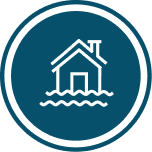 Flooding
Flooding
- Flooding in the Eurobodalla Shire consists of riverine flooding on the major river systems of the Clyde, Moruya and Tuross rivers and lake-embayment flooding along the coast; 22
- Major flooding is recorded as occurring in Eurobodalla Shire for the following locations: 23
- Clyde River: The highest floods were in November 1961 (13.18m) and March 1963 (12.62m), and a number of floods in the late 1800s which were unrecorded, 1914, 1916, 1925, 1934, 1941, 1942 and 1945, with 1934 purportedly being larger than the previous major flood in 1925 (which created records on many of the other rivers of the South Coast); and
- Moruya River: The most significant flood in the Moruya River was in 1925 (height of 5.4m). Since then, floods have occurred in 1934, 1945, 1961, 1974, 1975, 1976, 1978, 1991 (considered a 1 in 5 year flood) and 1992 (a 1 in 7 year flood).
- Council has undertaken several flood studies to better understand current and future anticipated flood behaviour in the various river catchments and sub-catchments, including:
- The Batemans Bay Urban Creeks Flood Study (prepared by Rhelm) and adopted in 2021;
- Moruya Floodplain Management Plan (prepared by Patterson Britton & Partners) and adopted in 2004;
- Tomakin, Mossy Point and Mogo Flood Study; and
- Wagonga Inlet, Kianga and Dalmeny Flood Study. 24
- Council has constructed low level levees on the foreshores of Malabar lagoon to protect agricultural land, though they can be overtopped at a low flood level; and
- Based on potential event probability as provided by Risk Frontiers in 2021, annual average loss of residential, commercial and industrial buildings due to flood is estimated at 64 per cent. This accounts for high probability and a high-cost consequence of flood activity.
Actions taken or proposed
Eurobodalla Shire Council has committed to undertaking the following actions in their Local Strategic Planning Statement (some of which have been completed):
- Finalise and certify the Eurobodalla Coastal Management Program;
- Adopt the Narooma Floodplain Risk Management Plan and Batemans Bay Urban Creek Flood Study;
- Develop a Flood Management Code across Eurobodalla; and
- Prepare a Climate Adaption Plan. 25
Council is currently preparing the following flood studies: 26
- Batemans Bay Urban Creeks Floodplain Risk Management Study and Plan;
- Moruya Flood Study and Floodplain Risk Management Study and Plan; and
- Narooma Coastal Inlets Flood Risk Management Study and Plan.
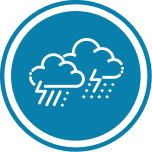 Severe storm
Severe storm
- Severe storms in NSW are often associated with East Coast Lows (ECL). ECL events are extreme weather systems that occur in South-East Australia, bringing extreme winds, rain, waves and elevated coastal water levels. These are most likely to form in the autumn months than other times of the year. 27
- There is estimated to be a decrease in the amount of severe storm days in the Shire based on modelling undertaken by Risk Frontiers.
- Based on potential event probability, annual average loss of residential, commercial and industrial buildings due to hail is estimated at 23 per cent. This accounts for low probability but high-cost consequence of hail activity.
Note: for the purposes of this report, cyclone was not commented on.
Actions taken or proposed
No immediate actions have been taken or proposed to address severe storms by Council. However, Council has highlighted the importance of planning for natural hazards, in their Local Strategic Planning Statement, including severe storms and any associated hazards such as riverine flooding, coastal inundation and erosion. Council has undertaken several actions to address coastal and flooding hazards (addressed previously).
 Storm tide inundation and erosion
Storm tide inundation and erosion
- The most severe problems of storm tide inundation / coastal erosion coincide with the passage of East Coast low-pressure systems. These have been known to cause temporary sea level rises, and can have particularly severe effects when weather conditions occur in conjunction with particularly high tides;
- Wharf Road, North Batemans Bay has specifically been identified as being one of the NSW coastal erosion ‘hot spots’. Other vulnerable areas to coastal erosion in the Batemans Bay area include:
- Surfside Beach;
- Cullendulla Beach;
- Long Beach;
- The Batemans Bay CBD,
- Beach Road, Corrigans Beach; and
- Casey’s Beach. 28
- A number of other coastal townships are also identified as being at risk from storm surge, including:
- Tuross Heads;
- Dalmeny;
- Kianga; and
- Narooma. 29
Actions taken or proposed
Eurobodalla Shire Council has highlighted the importance of identifying the risk of coastal erosion and inundation to the community in Council’s LSPS.
Council has also commenced undertaking its Coastal Management Program for both open coast areas and estuarine areas. When completed, will be the primary tool for managing these hazards.
 Bushfire and grassfire
Bushfire and grassfire
- Historically, the Shire has approximately 60 bushfires per year (on average), of which three or four can be considered severe. Major fires in extreme conditions, while rare, can be devastating;
- The region experienced its most significant and devastating fires in the region, which occurred during the summer of 2019-20. The fires of the 2019-20 fire season impacted approximately 80% of the Shire, consumed over 200,00ha of mainly forested land and destroyed more than 500 homes; 30
- The frequency of dangerous bushfire weather days and the magnitude of bushfire weather extremes will increase in the Shire;
- Grassfires can become common on hot days and heavy winds; and
- Based on potential event probability as provided by Risk Frontiers, annual average loss of residential, commercial and industrial buildings due to bushfire is estimated at 9 per cent. This accounts for low probability but high-cost consequence of bushfire activity.
Actions taken or proposed
Eurobodalla Shire Council has committed to undertaking the following actions in their Local Strategic Planning Statement (some of which have been completed):
- Collaborate with NSW Rural Fire Services in investigating the land use strategies across villages to achieve compliance with Planning for Bushfire Protection 2019; and
- Prepare a Climate Adaption Plan. 31
In addition, following the 2019-20 fire season, Council have undertaken a number of actions to build resilience to bushfire including:
- undertaking work to increase community resilience to bushfires, including independent power capabilities at various evacuation centres and establishing new facilities that can be used as a refuge during disaster events;32
- Preparing the Eurobodalla Shire Council Bushfire Recovery Action Plan to outline’s co-ordinated activities to rebuild, restore and rehabilitate the social, built, economic and natural environment at the Eurobodalla community.
Since the release of the Resilience Blueprint, the State Disaster Mitigation Plan (SDMP) was implemented in 2024. In addition to the above hazards, the SDMP generally covered the following:
 Landslide
Landslide
- The exposure to landslide risk in Eurobodalla Shire is considered to be low;
- Landslide can be triggered by severe weather events (e.g. heavy rainfall) or human activities (vegetation removal, overgrazing, slope modification, etc.); and 33
- Areas of Landslide Risk Land are mapped throughout Eurobodalla Shire in the Eurobodalla Local Environmental Plan identified as ‘Constrained land’ which applies to select rural and rural-residential locations throughout the Shire.
Actions taken or proposed
- No actions have been taken or proposed to address landslide risks within the Shire.
 Heatwave
Heatwave
- Heatwaves occur when the maximum and minimum temperatures are unusually hot over 3 days, based on the area’s regular conditions. Severe heatwaves can impact vulnerable populations (e.g. elderly, pregnant women, people with health conditions). Extreme heatwaves can have widespread health impacts on anyone unable to take precautions to keep cool whilst also impact infrastructure.34 Heatwaves events are known to impact Eurobodalla Shire.
Actions taken or proposed
- Following the 2019-20 fire season, Council undertook work to increase community resilience to bushfires, including independent power capabilities at various evacuation centres and establishing new facilities that can be used as a refuge during heatwave. 35
![]() Tsunami
Tsunami
- Tsunami’s can be generated by a number of causes, however, undersea earthquakes are the most likely to generate such an event in NSW. Tsunami waves can run up beyond the high tide mark causing significant damage to coastal areas.36
Actions taken or proposed
- No actions have been taken or proposed to address tsunami risks within the Shire.
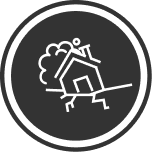 Earthquake
Earthquake
- The LGA has a low earthquake exposure, however it has experienced minor earthquakes in the past; and
- Based on potential event probability, annual average loss of residential, commercial and industrial buildings due to earthquakes is estimated at 5 per cent. This accounts for low probability but high cost consequence of earthquake activity.
Actions taken or proposed
- No actions have been taken or proposed as earthquake exposure in the LGA is very low.
Climate Change Data Summary

Heatwave – measured by number of days with temperatures greater than 35°C
Heatwaves are a critical climate hazard affecting health, infrastructure, and ecosystems. Heatwave risk can be measured by tracking the number of days per year with maximum temperatures exceeding 35°C. This analysis, undertaken by Risk Frontiers in 2021, drew on 20-year averages from historical climate reanalysis data and future climate model projections under a ‘medium’ emissions scenario, represented by RCP4.5 (see Figure 1 below).
Figure 1: Frequency of days per year with temperature greater than 35 Celsius Degrees
(Values are 20-year averages for present day climate and change for future climate under the RCP4.5 scenario.)
The data highlights how the frequency and seasonality of high-temperature events are expected to shift over time in the LGA, informing the need for climate adaptation in infrastructure, health, and planning decisions.
Key Findings:
- The magnitude of temperature extremes will increase in Eurobodalla;
- largest increases in heatwave and high temperature extremes will be seen during the summer months;
- high temperature extremes will also occur more frequently during spring and autumn.
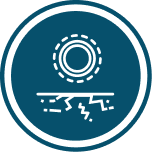
Drought – measured by Keetch-Byram Drought Index, soil moisture and annual precipitation
Drought is a complex hazard influenced by temperature, rainfall, and how water is retained in the landscape. To assess how drought conditions are projected to change in the LGA, this analysis undertaken by Risk Frontiers in 2021 used three key climate indicators:
- Keetch-Byram Drought Index (KBDI) – a widely used index that estimates how dry the landscape is based on temperature and rainfall. It also reflects the flammability of surface fuels and is commonly used for fire management (see Figure 2 below);
- Soil moisture percentiles – a direct measure of how much water is retained in the soil compared to long-term conditions. Soil moisture is essential for agriculture, vegetation health, and ecosystem resilience (see Figure 3 below); and
- Total annual precipitation – tracks overall rainfall trends, which are a key input for drought but must be considered alongside evaporation and temperature to understand drought risk fully (see Figure 4 below).
Figure 2: Annual mean Keetch-Byram Drought Index (KBDI) drought index value normalised on a scale of 0-10, where 10 is the maximum drought possible
(Values are 20-year averages for present day climate and change for future climate under the RCP4.5 scenario)
Figure 3: Annual mean soil moisture percentiles; values are calculated relative to present day climate, hence the 50% values for present day. Low values at 2070 are indicative of a drying landscape
(Values are 20-year averages for present day climate and change for future climate under the RCP4.5 scenario)
Figure 4: Total annual precipitation in mm per year
(Values are 20-year averages for present day climate and change for future climate under the RCP4.5 scenario)
These indicators are derived from climate model simulations using 20-year averages for present-day and future scenarios under RCP4.5. Together, they provide a fuller picture of both short-term and long-term drought potential, capturing the interplay between rainfall, heat, and water retention in the landscape.
Key Findings:
- By 2070 the magnitude of drought will increase across the Shire as soil moisture declines by 2070, with the greatest impact occurring during the winter and spring; and
- changes in total annual rainfall are less than the projected changes in soil moisture and drought, suggesting that the increase in drought is being driven primarily by increasing temperatures and their effect on evapotranspiration.

Bush and grassfire – measured by the annual maximum Forest Fire Danger Index (FFDI)
Bushfires and grassfires are among the most dangerous and disruptive climate-related hazards in South-East NSW Region. The annual maximum Forest Fire Danger Index (FFDI) is the nationally recognised measure for assessing bushfire danger and is widely used by emergency services to guide fire warnings, restrictions, and preparedness. FFDI is a composite index that incorporates temperature, wind speed, humidity, and recent rainfall to estimate how dangerous fire weather is on a given day.
This analysis undertaken by Risk Frontiers in 2021 used 20-year averages from historical reanalysis data and future climate projections under the RCP4.5 scenario (see Figure 5 below). This indicator helps identify trends in both the severity and seasonal timing of fire weather across the LGA.
Figure 5: Magnitude of bushfire weather severity as represented by the annual maximum FFDI
(Values are 20-year averages for present day climate and change for future climate under the RCP4.5 scenario)
Key Findings:
- the frequency of dangerous bushfire weather days and the magnitude of bushfire weather extremes will increase in the Shire;
- average fire weather is projected to increase in summer and spring, with the number of severe fire weather days also projected to increase during these months; 37 and
- the largest changes for bushfire weather across southeast Australia are expected to be occurring during the spring, with a projected earlier onset of the bushfire season under a warmer climate.

Extreme rainfall and flooding – measured by daily precipitation over 30mm
Flooding poses a significant hazard to infrastructure, communities, and emergency services. This analysis uses the frequency of very heavy rainfall days (daily rainfall greater than 30mm) as an indicator of flood risk. This threshold (i.e., days with more than 30mm of rain often) is a recognised benchmark in climate and hydrological studies to identify rainfall events that can overwhelm stormwater systems, trigger flash flooding, and lead to significant overland flow.
Projections done by Risk Frontiers in 2021 compared 20-year averages for present day conditions with those for 2030 and 2070 under the RCP4.5 scenario (see Figure 6 below). This helps to understand how the intensity of rainfall events changes, which is crucial for flood management, infrastructure design, and emergency planning.
Figure 6: Frequency of very heavy rainfall days (>30mm)
(Values are 20-year averages for present day climate and change for future climate under the RCP4.5 scenario)
Key Findings:
- Under present day climate there are on average 6 very heavy rainfall days per year with highest frequency in Eurobodalla, which are likely to be associated with east coast lows;
- the primary driver of year-to-year variability in rainfall will continue to be the tropical climate drivers of Indian Ocean Dipole (IOD), El Niño Southern Oscillation (ENSO) and the Inter-decadal Pacific Oscillation (IPO). Projections for Pacific climate are indicating an increase in ENSO amplitude, meaning both El Niño and La Niña events will be stronger;
- extreme rainfall events will produce higher rainfall totals due to the physical relationship between a warmer temperatures and higher atmospheric moisture capacity;
- rainfall is projected to decrease in spring and winter, but increase in summer and autumn; 38 and
- higher rainfall totals may lead to higher flood levels during flooding events, but the frequency of these events will not differ significantly from present.

Severe storm, wind and hail – measured by East Coast Low (ECL) days and annual windspeed
Severe storms, ranging from East Coast Lows to thunderstorms and hail events, pose a recurring hazard to communities and infrastructure. This analysis uses two key indicators to evaluate storm-related risk under a changing climate:
- frequency of East Coast Low (ECL) days – ECLs are among the most damaging storm systems affecting the region, often associated with extreme winds, heavy rainfall, large waves, and coastal erosion. Tracking their frequency is important for understanding long-term storm risks (see Figure 7 below).
- annual maximum windspeed – is used to assess the strength of storm systems and frontal weather events that can bring down trees, damage infrastructure, and increase fire danger (see Figure 8 below).
Figure 7: Frequency of east coast low days
(Values are 20-year averages for present day climate and change for future climate under the RCP4.5 scenario)
Figure 8 – Annual maximum windspeed (km/hr).
(Values are averaged across each LGA and calculated as 20-year averages for present day climate and change for future climate under the RCP4.5 scenario—windspeeds at individual locations and years will be significantly higher than the averages.)
These indicators help assess changes in both the occurrence and severity of damaging weather systems.
Projections done by Risk Frontiers in 2021 were based on 20-year averages comparing present-day conditions with future scenarios for 2050 and 2070 under RCP4.5. This helps identify trends in the intensity and potential impacts of storm systems in the LGA which may influence risk planning, emergency management, and infrastructure resilience.
Key Findings:
- Under present day climate, the Shire is exposed to several types of storms, including east coast lows (ECL), extra-tropical lows, fronts, snowstorms, thunderstorms, and hailstorms;
- ECL are one of the most damaging storm types to impact the Shire. ECL frequency is expected to increase slightly under future climate which is consistent with an expectation of increased large scale interactions between warm and cool air masses as the climate warms;
- extratropical lows and associated fronts and thunderstorms can cause significant risk, especially during summertime when they are a primary cause of dangerous bushfire weather; and
- maximum annual windspeed is projected to increase across the Shire, suggesting an increase in the strength of frontal systems.
Sea-level rise and coastal flooding – measured by IPCC historical and project sea level rise observations and projections, and storm tide inundation depths
Figure 9: Historical and projected sea level rise from observations and climate model projections from the latest IPCC report
Note: The projections for each of five scenarios are shown in colour. Shades represent uncertainty ranges.
Figure 10: Modelled storm tide inundation depths (m) for a 1-100 year event based on G-NAF addresses including SLR estimates
- sea levels are currently rising at a rate of ~3.7mm/year and projections are for up to 1m sea level rise by 2100 under RCP8.5, and are projected to rise by 23cm above 2014 by 2050 and 72cm by 2100; 39
- sea level rise impacts can be experienced during extreme events such as increased magnitude of storm tide flooding or increased coastal erosion during extreme wave events. They can also impact over longer timescales such as such as ecosystems changes and contamination of aquifers; and
- for Bega Valley and Eurobodalla there are currently 160 identified properties at risk of a one in 100-year storm tide coastal flooding event. Average exposure is 0.22m, with highest exposure (>1m) at Narooma, Tomakin, and Mossy Point. This is expected to increase to 287 exposed properties by 2030, and 989 by 2070 under RCP4.5.
NarCLIM 2.0 findings for Eurobodalla Shire
In 2022 NARClim 2.0 climate data was publicly released – this is the most up-to-date regional climate modelling available for NSW and ACT and is used Government planning, assessments, and strategies.
Table 2 below describes the anticipated future climate projections specific to Eurobodalla Shire based on NARCLiM 2.0 RCP4.5 (medium emissions) and RCP8.5 (high emissions) scenarios.
This information can be viewed through can be interactive climate change project map via https://www.climatechange.environment.nsw.gov.au/projections-map
Table 2: Future climate predictions for Eurobodalla Shire Council
Risk Exposure Summary
Hazards
A hazard is a natural process or occurrence, a source event which has the potential to result in harm or cause loss or damage depending on exposure. The Eurobodalla Local Emergency Management Committee have identified the following hazards as having risk of causing loss of life, property, utilities, services and/or the community’s ability to function within its normal capacity:
|
|
|
In 2024, the NSW State Disaster Mitigation Plan identifies these additional 3 hazards having the same risk to life and property:
- Coastal hazard (erosion and inundation);
- Storms and cyclones;
- Tsunami41
Climate modelling helps us to examine the implications for hazard likelihood. The Climate modelling performed by Risk Frontiers as part of the Resilience Blueprint found that Eurobodalla has:
- moderate flood hazard risk with 11.50% of the land within a modelled floodplain. This is particularly concentrated around the coastal settlements of Batemans Bay, Moruya and Bodalla due to both storm surge and riverine flood influences (see Figure 11 below); and
- moderate bush and grassfire hazard risk with a modelled annual burning probability of 0.51%. This risk area is largely confined to the environment protection and rural zones (see Figure 12 below).
Figure 11: Eurobodalla Flood Hazard Index
A dark blue indicates a flood plain, the lighter colour out of it.
The flood hazard index uses a map of modelled flood plains identified by several geographical/geospatial variables including different river types, river stream order, distance to river network, land cover, soil type, average slopes in known flood areas, relative changes in elevation near rivers, and river basin characteristics.
Figure 12: Eurobodalla Bush-Grass Fire Hazard Index
Life, Property, Economic and Environmental Loss Risk
Fatalities and life loss
Figure 13: Eurobodalla Fatalities from Natural Hazard
As shown in Figure 13, the risk that is posed to life is very difficult but a reality to of natural hazards. From a human health perspective, life loss throughout the region from 1900 to 30 June 2020 has been analysed using PerilAUS, Risk Frontiers’ database of natural hazard impacts. The analysis found that in Eurobodalla floods have resulted in the most fatalities – 6 fatalities, followed by bushfire (4 fatalities), gust (1 fatality), lightning (1 fatality) and hazardous surf (1 fatality).
Despite the above, more lives have been lost as a result of the impacts of disaster events across the Shire in the days, weeks, months and years that follow. The physical and mental health toll of events is enormous. It also does not capture cascading health issues and fatalities. Data in these regards is difficult to bring together but does not change the reality of the pervasive impact of disasters.
Impact on Property and Infrastructure
Figure 14: Distribution of the Average Annual Loss (AAL) of infrastructure by hazard for Eurobodalla
In terms of the risks posed to property and infrastructure, Risk Frontiers’ Natural Catastrophe loss models have been used to estimate the financial cost, or Average Annual Loss (AAL) across four key hazards in the Shire being bushfire, flood, hailstorm and earthquake. The models evaluated losses for commercial, residential and industrial properties.
Under current conditions, the overall baseline AAL for Eurobodalla is approximately $9 million and the analysis found that riverine flood is the most significant natural hazard accounting for 63% of the AAL, followed by hail (23%) as shown in Figure 14 above.
Mountains City Council and Central Coast Council). Eurobodalla Shire was identified has comprising:
- The highest bush fire risk in the social environment.
- The second highest bush fire risk in the natural environment (behind the Blue Mountains City Council).
This means that a bushfire would be particularly impactful in Eurobodalla, with impacts identified in Table 3 below.
Average Annual Loss identified in the State Disaster Mitigation Plan
Eurobodalla is identified as being within the top 3 LGAs in NSW with the highest bush fire hazard in the state (including Blue Mountains City Council and Central Coast Council). Eurobodalla Shire was identified has comprising:
- The highest bush fire risk in the social environment.
- The second highest bush fire risk in the natural environment (behind the Blue Mountains City Council).
This means that a bushfire would be particularly impactful in Eurobodalla, with impacts identified in Table 3 below.

Eurobodalla is also within the top 20 LGAs for total AALs ($ million) in the built environment, scoring 11th highest of all of the 128 council areas in NSW.
The SDMP indicates that the AAL in the Eurobodalla LGA for built environment in 2023 consisted of the following:
- Coastal hazard (erosion and inundation) – Very Low;
- Storms – Moderate;
- Cyclones – Very Low; and
- Tsunami – not recorded but moderate AAL noted in the SDMP.
Editors note: the SDMP does not include specific AAL per LGA. It is colour coded on a scale from $0m to $112m.
Environmental Loss Risk
Risks to threatened flora, fauna and ecological communities from fire and flood were analysed using the following values:
|
|
|
The fire and flood indices were overlaid with an exposure index locating threatened flora, fauna and ecosystems along with agricultural lands. The analysis found that there are:
- Fauna exposure is high. There are 26 different vulnerable animal species in the Shire, of which 14 are vulnerable, 7 are endangered, and 5 are critically endangered;
- Flora exposure is medium/high. There are 20 different vulnerable plant species in the Shire, of which 18 are vulnerable, and 2 are endangered; and
- Ecological community exposure is low/moderate. There are 6 different vulnerable ecological communities in the Shire, of which 5 are critically endangered and 1 is endangered.
The analysis also found that the natural environment encompasses 86.41% of the Shire (42.67% of which is protected), 5.66% devoted to agriculture and farming and the remaining 7.93% is developed built environment.
The total maximum above ground biomass (indicating the potential vegetation density the LGA could support) is moderate with 4,729 tonnes of dry matter over the LGA.
Overall, Eurobodalla’s environment has moderate exposure as seen in Error! Reference source not found.. This exposure index aligns with the ecological community index which shows high exposure of the endangered ecological communities west of the Shire.
Agricultural Productivity
While there are no significant changes for rainfall, warming temperatures will directly lead to lower overall soil moisture as seen in Table 1. A projected decrease in soil moisture from a warmer climate may impact agricultural productivity, especially dairy operations in Eurobodalla.
There is a correlation between agricultural productivity and climate parameters representing temperature and hydroclimate variability. Productivity of dairy and beef cattle operations tends to be higher during years that are wetter with retained soil moisture and low risk of drought. This correlation is particularly apparent for dairy operations, but a similar, yet weaker correlation can be seen for beef cattle operations as shown in Figure 16.
Vulnerability and Capacity
Resilience is generally regarded as a function of the intersection of relative exposure, social vulnerability and community capacity:
- Relative exposure is a function of hazard, describing the frequency and magnitude of natural hazard events and capturing the compounding effect of multiple hazards (fire and flood for this analysis);
- Physical exposure of a community is determined such that the quantum of exposed people, buildings, essential facilities, industry, and agriculture can be evaluated;
- Social vulnerability is determined by examining socio-economic and demographic factors that may exacerbate or ameliorate the effects of an external threat to a person’s life, livelihood, or assets; and
- Community capacity to resist, avoid and / or adapt to a disaster and to use these abilities to create security either before or after a disaster can be determined by examining several factors.
For each of these measurement framework indicators, an index has been produced by a weighted average of each metric contributing to the category. An analysis of the measurement framework indicators for each Statistical Area 1 (SA1) across South East NSW culminates as an integrated index of resilience; Figure 17 and Figure 18 shows community resilience indices for Eurobodalla.
- In Eurobodalla, the mean relative exposure component of the resilience index is low average for both bush/grass fire and for flood. 17.1% of the population reside in SA1s scoring low or worse for the relative exposure component of resilience to flood and 24.5% score low or worse for the relative exposure component of resilience to bush/grass fire (see Figure 19 and Figure 20 below);
- The Shire’s mean social vulnerability score is low average. 46.5% of the population residing in SA1s scoring low or worse for the social vulnerability component of resilience (see Figure 21 below); and
- The mean community capacity component of the resilience index is low average for both bush/grass fire and for flood. 38.7% of the population reside in SA1s scoring low or worse for the community capacity component of resilience to flood and 36.4% reside in SA1s scoring low or worse for the community capacity component of resilience to bush/grass fire (see Figure 22 and Figure 23 below).
Gaps in Data
While this local profile is underpinned by robust regional data and hazard modelling, several key data gaps remain that limit the precision of localised risk reduction planning:
- Community preparedness and capacity indicators: No recent community survey data exists on disaster readiness, access to emergency plans, or levels of volunteering in disaster response organisations.
- Historical event records: Detailed local records on the frequency, impacts, and recovery costs of past snow, storm, hail, and earthquake events are limited or not centralised.
- Economic disruption data: There is insufficient insight into how previous disasters have impacted the local economy, particularly small businesses, tourism, and agricultural supply chains.
- Infrastructure interdependencies: Modelling on critical infrastructure interdependencies (e.g., how flood risk to roads affects emergency access or supply deliveries) is not available at the LGA level.
- Monitoring and evaluation systems: Council currently lacks a framework to consistently track resilience outcomes over time, including climate impact monitoring and post-disaster recovery effectiveness.
- Integration of hazard overlays into planning instruments: While hazard data exists (e.g., fire and flood overlays), there is limited evidence that these are fully embedded within the Local Environmental Plan (LEP) or Development Control Plan (DCP), limiting the effectiveness of risk-informed development controls.
Reference
- Goulding Heritage Consulting Pty Ltd, 2005, ‘Eurobodalla Aboriginal Cultural Heritage Study: South Coast New South Wales’. Available online at https://www.esc.nsw.gov.au/community/Arts,-culture,-and-heritage/aboriginal-culture/aboriginal-cultural-and-heritage-projects
- .idconsulting, 2025, ‘Welcome to Eurobodalla Shire Council Community Profile’. Available online at https://profile.id.com.au/eurobodalla
- Ibid.
- .idconsulting, 2025, ‘Eurobodalla Shire: Population and dwellings’. Available online at https://profile.id.com.au/eurobodalla/population
- Ibid.
- Ibid.
- .idconsulting, 2025, ‘Eurobodalla Shire: Five year age groups’. Available online at https://profile.id.com.au/eurobodalla/five-year-age-groups
- Ibid.
- .idconsulting, 2025, ‘Eurobodalla Shire: Need for assistance’. Available online at https://profile.id.com.au/eurobodalla/assistance
10.
- .idconsulting, 2025, ‘Eurobodalla Shire: Language used at home’. Available online at https://profile.id.com.au/eurobodalla/language
- Ibid.
- .idconsulting, 2025, ‘Eurobodalla Shire: Agriculture’. Available online at https://economy.id.com.au/eurobodalla/value-of-agriculture
- .idconsilting, 2025, ‘Eurobodalla Shire: Tourism value’. Available online at https://economy.id.com.au/eurobodalla/tourism-value
- .idconsilting, 2025, ‘Eurobodalla Shire: Employment by industry (Total)’. Available online at https://economy.id.com.au/eurobodalla/employment-by-industry
- .idconsulting, 2025, ‘Eurobodalla Shire: Worker productivity’. Available online at https://economy.id.com.au/eurobodalla/worker-productivity-by-industry
- .idconsulting, 2025, ‘Eurobodalla Shire: Gross Regional Product’. Available online at https://economy.id.com.au/eurobodalla/gross-regional-product
- .idconsulting, 2025, ‘Eurobodalla Shire: Tourism Value’. Available online at https://economy.id.com.au/eurobodalla/tourism-value
- Eurobodalla Shire Council, 2023, ‘Local Emergency Management Plan Edition 4’. Available online at https://www.esc.nsw.gov.au/__data/assets/pdf_file/0020/134435/Eurobodalla-Local-Emergency-Management-Plan-edition-4.pdf
- Ibid.
- Eurobodalla Shire Council, 2025, ‘Councillors’. Available online at https://www.esc.nsw.gov.au/council/councillors
- NSW State Emergency Services, 2023, ‘Eurobodalla LGA Local Flood Emergency Sub Plan’. Available online at: https://www.ses.nsw.gov.au/sites/default/files/2024-02/eurobodalla-shire-lfp-jul-2023-endorsed.pdf
- Ibid.
- Eurobodalla Shire Council, (n.d.), ‘Flood Studies’. Available online at: https://www.esc.nsw.gov.au/environment/coast-and-waterways/flood-studies
- Eurobodalla Shire Council, 2020, Eurobodalla Local Strategic Planning Statement 2020 – 2040. Available online at https://www.esc.nsw.gov.au/__data/assets/pdf_file/0003/161625/Eurobodalla-Local-Strategic-Planning-Statement.pdf
- Eurobodalla Shire Council, 2025, ‘Flood Studies’. Available online at https://www.esc.nsw.gov.au/environment/coast-and-waterways/flood-studies
- NSW State Emergency Services, 2023, ‘Eurobodalla LGA Local Flood Emergency Sub Plan’. Available online at: https://www.ses.nsw.gov.au/sites/default/files/2024-02/eurobodalla-shire-lfp-jul-2023-endorsed.pdf
- NSW State Emergency Services, 2023, ‘Eurobodalla LGA Local Flood Emergency Sub Plan’. Available online at: https://www.ses.nsw.gov.au/sites/default/files/2024-02/eurobodalla-shire-lfp-jul-2023-endorsed.pdf
- NSW State Emergency Services, 2023, ‘Eurobodalla LGA Local Flood Emergency Sub Plan’. Available online at: https://www.ses.nsw.gov.au/sites/default/files/2024-02/eurobodalla-shire-lfp-jul-2023-endorsed.pdf
- Eurobodalla Bush Fire Management Committee, 2019, ‘Bush Fire Risk Management Plan’. Available online at https://www.rfs.nsw.gov.au/__data/assets/pdf_file/0017/2366/Eurobodalla-BFRMP.pdf
- Eurobodalla Shire Council, 2020, ‘Eurobodalla Local Strategic Planning Statement 2020 – 2040’. Available online at https://www.esc.nsw.gov.au/__data/assets/pdf_file/0003/161625/Eurobodalla-Local-Strategic-Planning-Statement.pdf
- Eurobodalla Shire Council, 2022, ‘Eurobodalla Climate Action Plan 2022-2032’. Available online at https://www.rfs.nsw.gov.au/__data/assets/pdf_file/0017/2366/Eurobodalla-BFRMP.pdf
- NSW Reconstruction Authority, 2024, ‘State Disaster Mitigation Plan 2024-2026’. Available online at https://www.nsw.gov.au/sites/default/files/noindex/2024-02/State_Disaster_Mitigation_Plan_Full_Version_0.pdf
- Eurobodalla Shire Council, 2023, ‘Eurobodalla Climate Action Plan 2022-2032’. Available online at: https://www.esc.nsw.gov.au/__data/assets/pdf_file/0012/221223/Eurobodalla-Climate-Action-Plan-2022-2032.pdf
- Ibid.
- NSW State Emergency Service, 2023, ‘New South Wales State Tsunami Plan’. Available online at https://www.nsw.gov.au/sites/default/files/noindex/2024-02/2023_NSW_State_Tsunami_Plan.pdf
- Eurobodalla Shire Council, 2022, ‘Eurobodalla Climate Action Plan 2022-2032’. Available online at https://www.rfs.nsw.gov.au/__data/assets/pdf_file/0017/2366/Eurobodalla-BFRMP.pdf
- Eurobodalla Shire Council, 2022, ‘Eurobodalla Climate Action Plan 2022-2032’. Available online at https://www.rfs.nsw.gov.au/__data/assets/pdf_file/0017/2366/Eurobodalla-BFRMP.pdf
- Eurobodalla Shire Council, 2022, ‘Eurobodalla Climate Action Plan 2022-2032’. Available online at https://www.rfs.nsw.gov.au/__data/assets/pdf_file/0017/2366/Eurobodalla-BFRMP.pdf
- Eurobodalla Shire, Council, 2019, ‘Local Emergency Management Plan: Edition 4’. Available online at: https://www.esc.nsw.gov.au/__data/assets/pdf_file/0020/134435/Eurobodalla-Local-Emergency-Management-Plan-edition-4.pdf
- NSW Reconstruction Authority, 2024, ‘State Disaster Mitigation Plan 2024-2026’. Available online https://www.nsw.gov.au/sites/default/files/noindex/2024-02/State_Disaster_Mitigation_Plan_Full_Version_0.pdf
- NSW Reconstruction Authority, 2024, ‘State Disaster Mitigation Plan 2024-2026’. Available online at https://www.nsw.gov.au/sites/default/files/noindex/2024-’02/State_Disaster_Mitigation_Plan_Full_Version_0.pd































